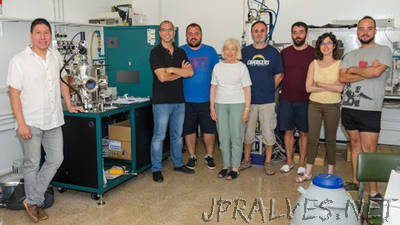
“In order to store information in the conventional magnetic memories of electronic devices, the materials’ small magnetic domains are oriented “up” or “down” by using externally applied magnetic fields. To generate these fields it is necessary to produce electric currents, but these currents heat up materials and a large amount of energy is needed to be spent to cool them. Practically 40% of the electrical energy used by computers (or “Big Data” servers) is dissipated as heat. In 2007, French scientists observed that when magnetic materials are grown as ultra-thin layers and voltage is applied, the amount of current and energy needed to orient the magnetic domains was reduced by 4%. However, this slight reduction was not significant enough to be of interest for practical devices. A research team led by Jordi Sort, ICREA Research Professor and Lecturer of the Department of Physics at the Universitat Autònoma de Barcelona, with the collaboration of the Catalan Institute for Nanoscience and Nanotechnology (ICN2), has searched for a solution based on the magnetic properties of a new nanoporous material with very high surface area. The new material, which is featured this week in the Advanced Functional Materials journal, consists in nanoporous copper-nickel alloy films, organised in a way that the interior forms surfaces and holes similar to that of the inside of a sponge, but with a separation between pores (i.e., thickness of the pore walls) of only 5 or 10 nanometres. In other words, the walls of the pores contain room for only a few dozens of atoms. “There are many researchers using nanoporous materials to improve physical-chemical processes, such as in the development of new gas sensors or catalysts, but we studied what these materials could provide to electromagnetism”, Prof. Jordi Sort explains. “The nanopores found on the inside of nanoporous materials offer a great amount of surface. With this vast surface concentrated in a very small space we can apply a small voltage and enormously reduce the energy needed to orient the magnetic domains and record data. This represents a new paradigm in the energy saving of computers and in computing and handling magnetic data in general”, says Jordi Sort. UAB researchers have built the first prototypes of nanoporous magnetic memories based on copper-nickel (CuNi) alloys and have reached very satisfactory results, with a reduction of 35% in magnetic coercivity, a magnitude related to the magnetic field (i.e., energy consumption) needed to switch the orientation of magnetic bits. In these first prototypes, the UAB researchers applied the voltage using liquid electrolytes, but they are now working on developing solid dieletrics which could prompt the use of these devices in the market. According to Jordi Sort, “Implementing this material into the memories of computers and mobile devices can offer many advantages, mainly in direct energy saving for computers and considerable increase in the autonomy of mobile devices”. The development of new nanoelectronic devices with improved energy efficiency is one of the strategic lines included in the European Union’s Horizon 2020 programme. According to some estimations, if electric current is completely substituted by voltage in data processing systems, energy costs could be reduced by a factor of 1/500.In fact, computer servers of large companies such as Google and Facebook are located underwater, or in Nordic countries in which temperatures are very low, with the aim of reducing heating and energy consumption.”
